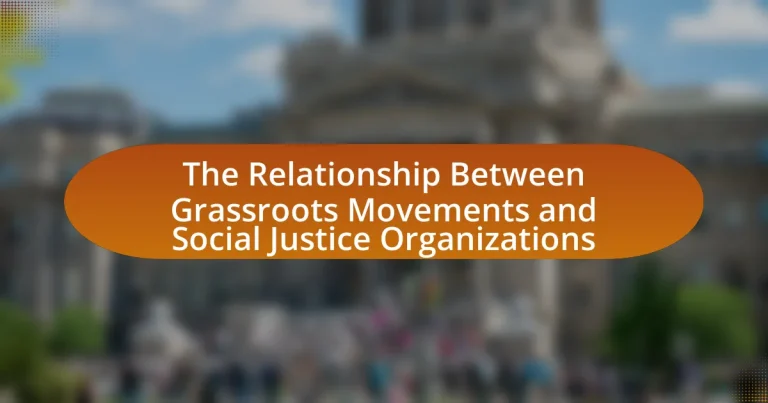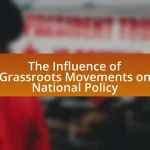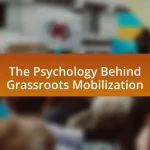Grassroots movements are community-driven initiatives aimed at enacting social change by mobilizing individuals to advocate for their rights, while social justice organizations are formal entities focused on promoting equality and addressing systemic injustices through advocacy and policy reform. This article explores the relationship between grassroots movements and social justice organizations, highlighting their distinct characteristics, collaborative efforts, and the challenges they face together. It examines how grassroots movements empower marginalized voices, influence policy change, and enhance community engagement, while also discussing the importance of effective communication and coalition-building strategies for achieving greater impact in social justice initiatives.
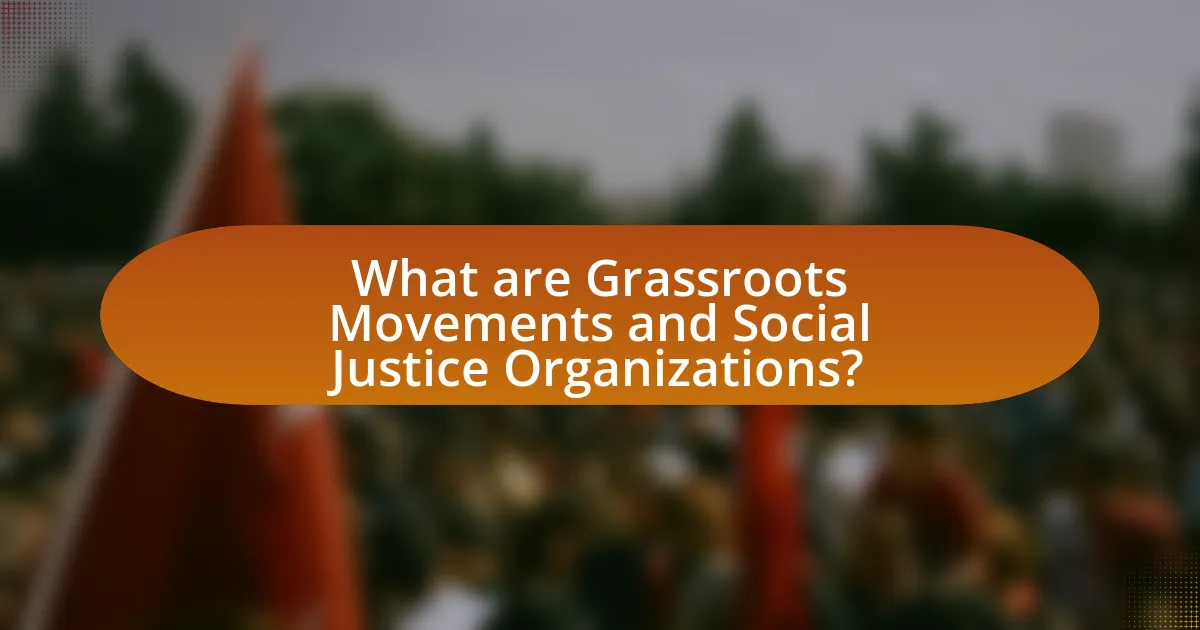
What are Grassroots Movements and Social Justice Organizations?
Grassroots movements are community-driven initiatives that seek to enact social change from the ground up, often focusing on local issues and mobilizing individuals to advocate for their rights and needs. Social justice organizations are formal entities that work to promote equality and address systemic injustices through advocacy, education, and policy reform. Both grassroots movements and social justice organizations often collaborate to amplify their impact, as grassroots efforts can provide the community engagement necessary for social justice organizations to effectively address broader societal issues. For example, the Civil Rights Movement in the United States involved grassroots activism alongside established organizations like the NAACP, demonstrating how these entities can work together to achieve significant social change.
How do Grassroots Movements differ from Social Justice Organizations?
Grassroots movements differ from social justice organizations primarily in their structure and approach to advocacy. Grassroots movements are typically decentralized, driven by local community members who mobilize around specific issues, often without formal leadership or organizational hierarchy. In contrast, social justice organizations usually have a structured framework, established leadership, and defined missions focused on broader systemic change. For example, grassroots movements like the Civil Rights Movement in the 1960s emerged from local communities advocating for immediate change, while organizations like the NAACP operated within a formal structure to address civil rights through legal and political channels. This distinction highlights how grassroots movements prioritize community-driven action, whereas social justice organizations often engage in strategic planning and policy advocacy.
What are the defining characteristics of Grassroots Movements?
Grassroots movements are characterized by their community-driven nature, emphasizing local participation and leadership. These movements typically arise from the collective efforts of individuals at the community level, seeking to address social, political, or environmental issues. They often rely on volunteer efforts and grassroots organizing strategies, such as door-to-door campaigning and community meetings, to mobilize support and raise awareness. A notable example is the Civil Rights Movement in the United States, which was largely driven by local activists and community leaders advocating for racial equality. This demonstrates how grassroots movements can effectively challenge systemic injustices and influence broader social change.
What roles do Social Justice Organizations play in society?
Social justice organizations play a crucial role in advocating for equality, human rights, and systemic change within society. They mobilize communities, raise awareness about social issues, and influence policy through activism and education. For instance, organizations like the American Civil Liberties Union (ACLU) have successfully challenged discriminatory laws and practices, contributing to landmark legal victories that protect civil rights. Additionally, social justice organizations often provide resources and support to marginalized groups, fostering empowerment and community resilience. Their efforts are essential in shaping public discourse and driving legislative reforms that promote social equity.
Why are Grassroots Movements important for Social Justice?
Grassroots movements are crucial for social justice because they empower marginalized communities to advocate for their rights and influence systemic change. These movements often arise from local issues and mobilize individuals to address injustices that affect their lives directly. For instance, the Civil Rights Movement in the United States, which was largely grassroots-driven, successfully challenged racial segregation and discrimination, leading to significant legislative changes such as the Civil Rights Act of 1964. This demonstrates how grassroots efforts can effectively bring about social justice by fostering community engagement, raising awareness, and applying pressure on institutions to enact reforms.
How do Grassroots Movements amplify marginalized voices?
Grassroots movements amplify marginalized voices by creating platforms for direct participation and advocacy, enabling individuals from underrepresented communities to express their needs and concerns. These movements often utilize community organizing, social media, and local events to mobilize support and raise awareness about issues affecting marginalized groups. For instance, the Black Lives Matter movement has effectively highlighted systemic racism and police brutality, leading to widespread public discourse and policy changes. Research indicates that grassroots initiatives can increase civic engagement among marginalized populations, fostering a sense of agency and empowerment, which is crucial for social justice.
What impact do Grassroots Movements have on policy change?
Grassroots movements significantly influence policy change by mobilizing community support and raising awareness on critical issues. These movements often highlight social injustices, leading to increased public pressure on policymakers. For instance, the Civil Rights Movement in the 1960s successfully advocated for the Civil Rights Act of 1964, demonstrating how organized grassroots efforts can lead to substantial legislative changes. Additionally, research by the Stanford Social Innovation Review indicates that grassroots campaigns can effectively shift public opinion, which in turn compels legislators to respond to constituents’ demands. This dynamic illustrates the powerful role grassroots movements play in shaping policy outcomes.
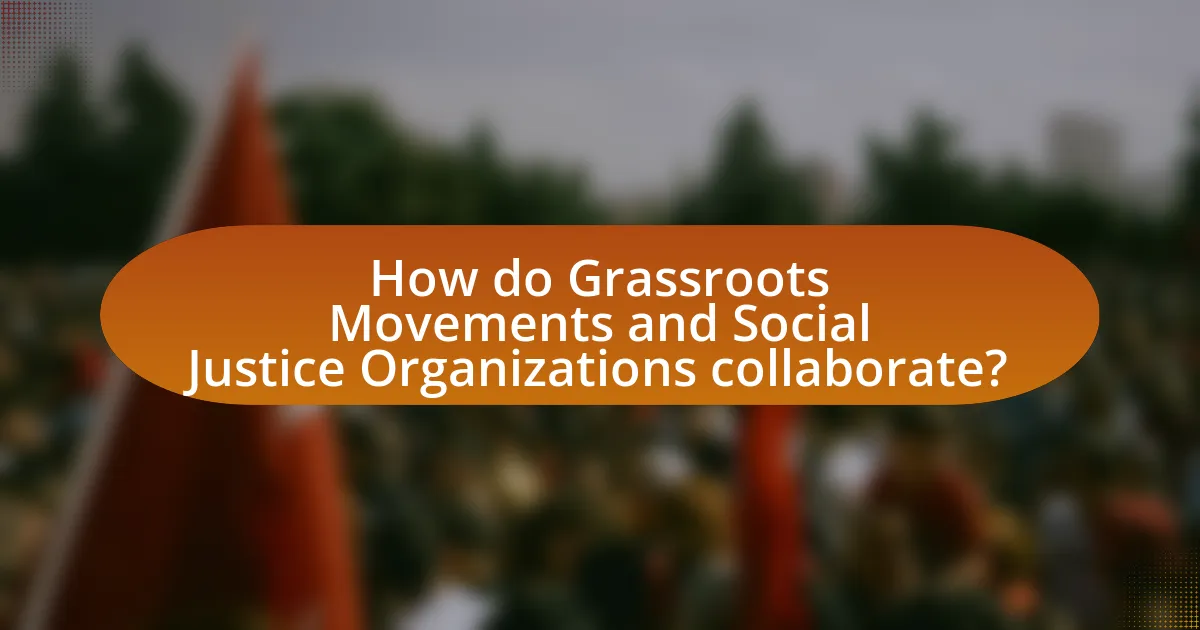
How do Grassroots Movements and Social Justice Organizations collaborate?
Grassroots movements and social justice organizations collaborate through shared goals, resource sharing, and coordinated actions. Grassroots movements often mobilize community members to advocate for change, while social justice organizations provide structure, funding, and expertise. For example, during the Black Lives Matter movement, grassroots activists worked alongside established organizations like the NAACP to amplify their message and reach broader audiences. This collaboration enhances visibility and effectiveness, as evidenced by the increased public engagement and policy discussions surrounding racial justice issues during these joint efforts.
What are the common goals shared by Grassroots Movements and Social Justice Organizations?
Grassroots movements and social justice organizations commonly aim to promote equity, advocate for marginalized communities, and drive systemic change. Both entities focus on addressing social injustices, such as racial discrimination, economic inequality, and environmental issues, by mobilizing community members and raising awareness. For instance, the Civil Rights Movement in the United States, which involved grassroots activism, sought to dismantle segregation and secure voting rights, aligning with the goals of various social justice organizations that worked towards similar objectives. This shared commitment to social equity and community empowerment underscores their collaborative efforts in effecting meaningful societal transformation.
How do these entities align their strategies for greater impact?
Grassroots movements and social justice organizations align their strategies for greater impact by collaborating on shared goals and leveraging each other’s strengths. Grassroots movements often mobilize community members and raise awareness about specific issues, while social justice organizations provide resources, expertise, and a broader platform for advocacy. For instance, the collaboration between the Black Lives Matter movement and established civil rights organizations has amplified calls for police reform and racial justice, demonstrating how grassroots activism can influence policy changes through strategic partnerships. This alignment is further supported by data showing that coordinated efforts can lead to increased public engagement and legislative success, as seen in various social movements throughout history.
What examples illustrate successful collaborations between the two?
Successful collaborations between grassroots movements and social justice organizations include the partnership between the Black Lives Matter movement and various civil rights organizations, such as the NAACP and the American Civil Liberties Union (ACLU). These collaborations have led to significant advocacy efforts, including the 2014 protests following the death of Michael Brown in Ferguson, which united grassroots activists and established organizations to demand police reform and racial justice. Additionally, the Women’s March in 2017 exemplified collaboration, as grassroots organizers worked alongside established feminist organizations to mobilize millions for women’s rights and social justice issues. These examples demonstrate how grassroots movements can amplify their impact through strategic alliances with established social justice organizations, resulting in broader awareness and policy changes.
How do Grassroots Movements support the work of Social Justice Organizations?
Grassroots movements support the work of social justice organizations by mobilizing community members, raising awareness, and providing a platform for marginalized voices. These movements often engage in local activism that complements the broader goals of social justice organizations, creating a synergy that enhances advocacy efforts. For example, grassroots initiatives can lead to increased participation in campaigns, as seen in movements like Black Lives Matter, which have galvanized support for organizations fighting systemic racism. This collaboration amplifies the reach and impact of social justice efforts, demonstrating the effectiveness of grassroots activism in driving social change.
What resources do Grassroots Movements provide to Social Justice Organizations?
Grassroots movements provide essential resources to social justice organizations, including community engagement, mobilization strategies, and grassroots funding. These movements often serve as a foundation for social justice initiatives by fostering local participation and activism, which enhances the reach and impact of organizations. For instance, grassroots movements can mobilize volunteers and activists, creating a network of support that amplifies the efforts of social justice organizations. Additionally, they often generate small-scale funding through community donations and fundraising events, which can be crucial for sustaining operations and initiatives. This collaborative dynamic strengthens the overall effectiveness of social justice efforts, as evidenced by successful campaigns that have emerged from grassroots origins, such as the Civil Rights Movement, which relied heavily on local organizing and community support to achieve significant legislative changes.
How do Grassroots Movements enhance community engagement for Social Justice Organizations?
Grassroots movements enhance community engagement for social justice organizations by mobilizing local populations to participate actively in advocacy efforts. These movements foster a sense of ownership and empowerment among community members, encouraging them to voice their concerns and contribute to social change initiatives. For example, the Black Lives Matter movement has successfully engaged diverse communities in discussions about racial justice, leading to increased participation in protests and local policy advocacy. This direct involvement not only amplifies the voices of marginalized groups but also strengthens the overall impact of social justice organizations by creating a more informed and active citizenry.
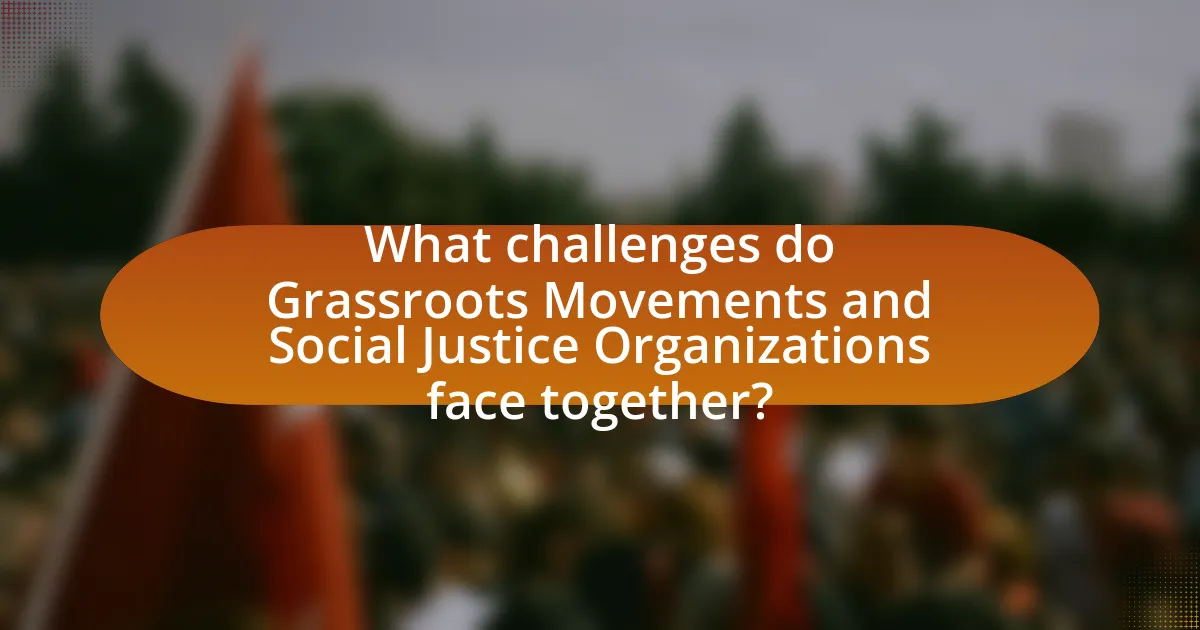
What challenges do Grassroots Movements and Social Justice Organizations face together?
Grassroots movements and social justice organizations face challenges such as limited funding, organizational fragmentation, and resistance from established power structures. Limited funding restricts their ability to mobilize resources effectively, as many rely on small donations or grants that may not cover operational costs. Organizational fragmentation occurs when differing priorities and strategies lead to a lack of cohesion, making it difficult to present a united front. Additionally, resistance from established power structures, including government entities and corporations, often manifests as legal barriers, public opposition, or even repression, hindering their efforts to enact change. These challenges collectively impede their effectiveness in advocating for social justice and equity.
What obstacles hinder the effectiveness of Grassroots Movements?
Grassroots movements face several obstacles that hinder their effectiveness, including limited resources, lack of media coverage, and internal conflicts. Limited resources restrict the ability to mobilize supporters and sustain activities, as many grassroots organizations operate on tight budgets and rely on volunteer efforts. Lack of media coverage diminishes visibility and public awareness, making it challenging to gain traction and support for their causes. Internal conflicts, such as differing priorities among members, can lead to fragmentation and weaken the overall impact of the movement. These factors collectively impede the ability of grassroots movements to achieve their goals and effect meaningful change.
How do funding issues affect Grassroots Movements and Social Justice Organizations?
Funding issues significantly hinder grassroots movements and social justice organizations by limiting their operational capacity and outreach. When financial resources are scarce, these organizations struggle to implement programs, mobilize communities, and sustain advocacy efforts. For instance, a report from the National Committee for Responsive Philanthropy indicates that only 7% of philanthropic funding goes to grassroots organizations, which often rely on small donations and volunteer efforts. This lack of funding can lead to reduced visibility and impact, making it difficult for these movements to challenge systemic injustices effectively. Furthermore, funding constraints can force organizations to prioritize short-term goals over long-term strategies, undermining their mission to create sustainable social change.
What role does public perception play in the challenges faced by these entities?
Public perception significantly influences the challenges faced by grassroots movements and social justice organizations. When the public views these entities positively, they are more likely to receive support, funding, and participation, which can enhance their effectiveness. Conversely, negative public perception can lead to decreased support, increased scrutiny, and potential backlash, hindering their initiatives. For instance, a study by the Pew Research Center found that public attitudes toward social movements can shift rapidly based on media portrayal and public discourse, impacting the movements’ ability to mobilize resources and advocate for change. Thus, public perception acts as a critical factor in determining the operational landscape for these entities.
How can Grassroots Movements and Social Justice Organizations overcome these challenges?
Grassroots movements and social justice organizations can overcome challenges by fostering collaboration and building coalitions. By uniting diverse groups with shared goals, these organizations can pool resources, amplify their voices, and increase their impact. For instance, the Civil Rights Movement in the United States successfully combined efforts from various grassroots organizations, leading to significant legislative changes such as the Civil Rights Act of 1964. Additionally, leveraging technology for outreach and mobilization can enhance their ability to engage supporters and raise awareness, as seen in recent movements like Black Lives Matter, which utilized social media to organize protests and disseminate information rapidly.
What strategies can be employed to build stronger coalitions?
To build stronger coalitions, organizations should prioritize clear communication, shared goals, and mutual respect among members. Clear communication fosters transparency and trust, which are essential for collaboration. Establishing shared goals aligns the efforts of diverse groups, ensuring that all members are working towards a common purpose. Mutual respect acknowledges the unique contributions of each coalition member, enhancing cooperation and commitment. Research indicates that coalitions with defined objectives and open dialogue are more effective; for example, a study by the National Council of Nonprofits found that organizations with strong communication practices reported higher levels of engagement and success in achieving their goals.
How can effective communication enhance their collaboration?
Effective communication enhances collaboration between grassroots movements and social justice organizations by fostering mutual understanding and aligning goals. When these entities communicate effectively, they can share resources, strategies, and insights, which leads to more coordinated efforts in advocating for social change. Research indicates that organizations with strong communication practices are 25% more likely to achieve their objectives, as they can quickly adapt to challenges and leverage collective strengths. This synergy not only amplifies their impact but also builds trust and solidarity, essential for sustained collaboration in social justice initiatives.
What best practices can Grassroots Movements and Social Justice Organizations adopt?
Grassroots movements and social justice organizations can adopt best practices such as building strong community relationships, utilizing data-driven strategies, and fostering inclusive participation. Strong community relationships enhance trust and collaboration, which are essential for mobilizing support and resources. Data-driven strategies enable organizations to assess their impact and refine their approaches based on evidence, as seen in the success of organizations like the Black Lives Matter movement, which effectively used social media analytics to amplify their message. Fostering inclusive participation ensures diverse voices are heard, leading to more comprehensive solutions; for instance, the Women’s March incorporated input from various marginalized groups to address intersectional issues. These practices collectively strengthen the effectiveness and sustainability of grassroots movements and social justice organizations.
How can they leverage technology for greater outreach?
Grassroots movements and social justice organizations can leverage technology for greater outreach by utilizing social media platforms to disseminate information rapidly and engage with a wider audience. For instance, platforms like Twitter and Facebook allow these organizations to share updates, mobilize supporters, and create viral campaigns that can reach thousands in a short time. According to a study by the Pew Research Center, 69% of adults in the U.S. use social media, making it a powerful tool for outreach. Additionally, using data analytics tools can help organizations understand their audience better and tailor their messages effectively, enhancing engagement and participation in their initiatives.
What methods can be used to measure the impact of their collaboration?
To measure the impact of collaboration between grassroots movements and social justice organizations, qualitative and quantitative methods can be employed. Qualitative methods include interviews and focus groups that gather personal narratives and experiences, providing insights into the perceived effectiveness of the collaboration. Quantitative methods involve surveys and data analysis, which can track metrics such as changes in community engagement, policy outcomes, or demographic shifts. For instance, a study by the Stanford Social Innovation Review highlights that measuring changes in public awareness or policy changes can serve as indicators of successful collaboration. These methods collectively provide a comprehensive understanding of the collaboration’s impact.
